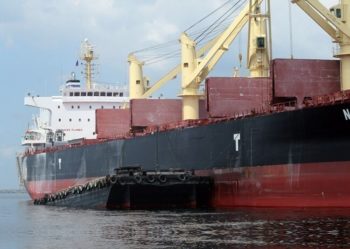
The International Maritime Organization (IMO) has issued a new warning that bauxite may become unstable when carried in bulk on a ship, potentially causing the vessel to capsize.
Research presented last week to an IMO Sub-Committee found that certain forms of bauxite with a large proportion of smaller particles could be subject to a newly-identified phenomenon of “dynamic separation” when there is excess moisture in the cargo.
In such conditions, a liquid slurry (water and fine solids) can form above the solid material, according to the report of a Global Bauxite Working Group (GBWG) on Research into the Behaviour of Bauxite during Shipping. As explained, the resulting free surface effect of liquid sloshing about could significantly affect the vessel’s stability, leading to the risk of the ship capsizing.
IMO’s Sub-Committee on Carriage of Cargoes and Containers (CCC 4) has raised awareness on the potential risks posed by moisture and provided new guidance on carriage of bauxite, in the form of a circular aimed at shippers, terminal operators, shipowners, ship operators, charterers, shipmasters and all other entities concerned.
The circular requests that extreme care and appropriate action be taken, taking into account the provisions of relevant IMO instruments when handling and carrying bauxite in bulk. The circular takes immediate effect, ahead of the next scheduled adoption (in 2019) of the new test methods and relevant schedules for bauxite cargoes during the routine scheduled updating of the International Maritime Solid Bulk Cargoes (IMSBC) Code. The IMSBC Code is the industry rulebook on how to deal with bulk cargoes.
The CCC 1 circular updates a previous circular on carriage of bauxite and invites governments to note that some bauxite cargoes present a risk caused by moisture and should be treated as Group A cargoes. Excess moisture in such cargoes can lead to a free surface slurry. This can cause atypical motion of the ship or wobbling. The master should take appropriate action in the event of this possible sign of cargo instability.
The circular includes the draft Test Procedure for Determining the transportable moisture limit (TML) for bauxite; the draft individual schedule for bauxite of Group A and draft amendments to the existing individual schedule for bauxite of Group C (bauxite with a lower proportion of smaller particles and with a degree of saturation by moisture not liable to reach 70%).
Bauxite is one of the world’s major sources of aluminium with around 100 million tons transported annually by sea. In 2015, the bulk carrier Bulk Jupiter sank while transporting bauxite, with the loss of 18 seafarers.
Following the accident, the global bauxite industry was requested by IMO to undertake research into the behavior of bauxites during ocean transportation.
Copyright Ships & Ports Ltd. Permission to use quotations from this article is granted subject to appropriate credit given to www.shipsandports.com.ng as the source.